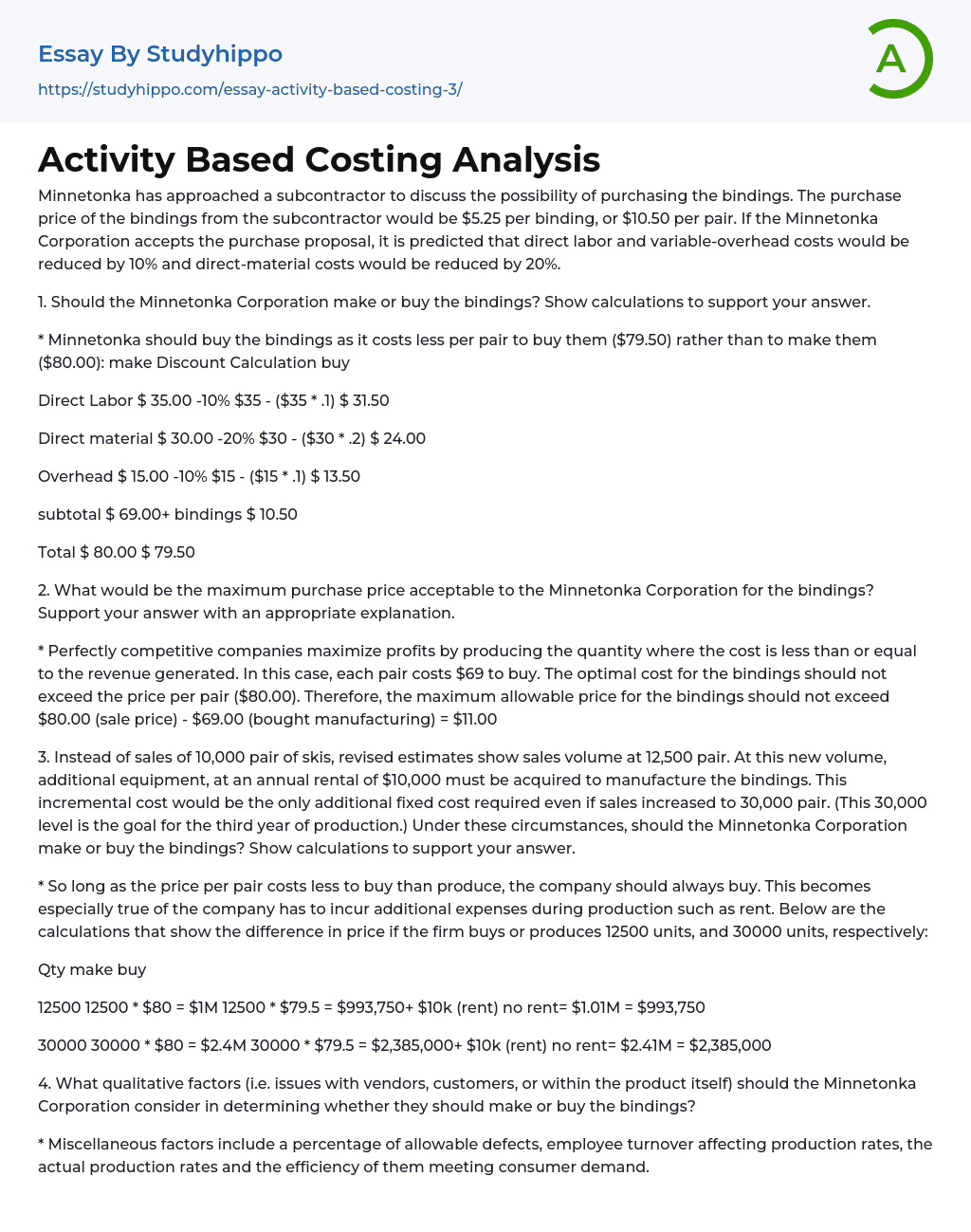Minnetonka has reached out to a subcontractor for the purpose of discussing the purchase of bindings. The subcontractor has proposed two options: either buying each binding at a price of $5.25, or purchasing a pair for $10.50.
If the Minnetonka Corporation accepts the purchase proposal, it is expected that the direct labor and variable-overhead costs will decrease by 10% and the direct-material costs will decrease by 20%.
- Should Minnetonka Corporation choose to make or buy the bindings? Provide calculations to support your answer.
* Minnetonka should buy the bindings as it is cheaper to buy them ($79.50) instead of making them ($80.00):
make Discount Calculation
buy
Direct Labor $35.00 -10% $35 - ($35 * .1) $31.50
Direct material $30.00 -20% $30 - ($30 * .2) $24.00
Overhead $15.00 -10% $15 - ($15 * .1) $13.50
subtotal $69.00+ bindings $10.50
Total $80.00 $79.50
-
...
- What would be the maximum acceptable purchase price for the bindings for Minnetonka Corporation? Support your answer with an appropriate explanation.
* In a perfectly competitive market, companies maximize profits by producing a quantity where the cost is less than or equal to the revenue generated.In this case, each pair costs $69 to buy.The optimal cost for the bindings should not exceed tprice per pair ($80).The maximum allowable price for the bindings should be $11.00, calculated as the difference between the sale price of $80.00 and the manufacturing cost of $69.00.
Revised estimates indicate that a sales volume of 12,500 pairs of skis will be achieved instead of the initial projection of 10,000 pairs.
To accommodate this increased volume, additional equipment must be acquired to manufacture the bindings. The annual rental cost for this equipment is $10,000.
If sales further increase to 30,00
pairs, the only additional fixed cost needed would be this incremental cost.
The Minnetonka Corporation is considering whether to make or buy the bindings. They should calculate the cost per pair to determine the most cost-effective option. If buying costs less than producing, the company should buy, especially if additional expenses like rent are incurred during production. The calculations for producing 12,500 units and 30,000 units are as follows:
- Qty make buy 12,500: 12,500 * $80 = $1M, 12,500 * $79.5 = $993,750+ $10k (rent) no rent= $1.01M = $993,750
- Qty make buy 30,000: 30,000 * $80 = $2.4M, 30,000 * $79.5 = $2,385,000+ $10k (rent) no rent= $2.41M = $2,385,000
The Minnetonka Corporation should also consider qualitative factors when determining whether to make or buy the bindings. These factors include issues with vendors, customers, or within the product itself. Other miscellaneous factors to consider are a percentage of allowable defects, employee turnover affecting production rates, the actual production rates, and the efficiency of meeting consumer demand.
- Accounting essays
- Marketing essays
- Automation essays
- Business Cycle essays
- Business Model essays
- Business Operations essays
- Business Software essays
- Corporate Social Responsibility essays
- Infrastructure essays
- Logistics essays
- Manufacturing essays
- Multinational Corporation essays
- Richard Branson essays
- Small Business essays
- Cooperative essays
- Family Business essays
- Human Resource Management essays
- Sales essays
- Market essays
- Online Shopping essays
- Selling essays
- Strategy essays
- Management essays
- Franchising essays
- Quality Assurance essays
- Business Intelligence essays
- Corporation essays
- Stock essays
- Shopping Mall essays
- Harvard Business School essays
- Harvard university essays
- Trade Union essays
- Cooperation essays
- News Media essays
- Waste essays
- Andrew Carnegie essays
- Inventory essays
- Customer Relationship Management essays
- Structure essays
- Starting a Business essays
- Accounts Receivable essays
- Auditor's Report essays
- Balance Sheet essays
- Costs essays
- Financial Audit essays
- International Financial Reporting Standards essays
- Tax essays
- Accountability essays
- Cash essays
- Principal essays




